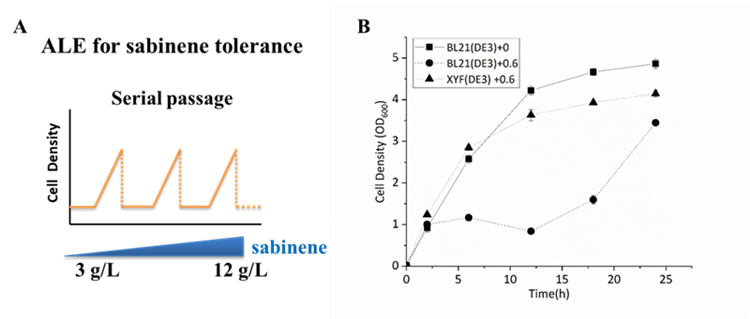Scientists Proposed New Mechanism of Synthesizing Terpene Compounds by Biological Method
Terpenes are widely used in medicine, food additives, cosmetics, biological control, energy industry and many other fields. Recent years, terpenes have attracted more and more attentions due to the high energy density, low freezing point, and low carbon emissions of their hydrogenated products which can be used in the manufacture of high-performance and high-density aviation fuels.
The traditional production of terpenes is extraction from natural plants or chemical synthesis. However, both methods have the problems of low yield, high energy consumption, complex process and heavy pollution. Along with the development of synthetic biology and the increasing demand for green and sustainable energy, using renewable sugars as raw materials and genetically-modified microorganisms as hosts to produce desired products has become new focus.
"Quite a lot of microbial fermentation products are organic solvents which exhibit a certain degree of toxicity against the host cells," said Prof. ZHANG Hai-bo, from Qingdao Institute of Bioenergy and Bioprocess Technology (QIBEBT). "However, most studies on the engineering of microbes to produce various chemicals focused on improving the metabolic efficiency of host strains, and relatively few studies focused on improving the tolerance of host strains to toxic products."
To increase the tolerance of Escherichia coli BL21(DE3) to sabinene, a bicyclic monoterpene, Prof. ZHANG’s group evolved the strain through adaptive laboratory evolution (ALE) and a sabinene-tolerant mutant XYF(DE3) was obtained. The sabinene production of XYF(DE3) reached 191.76 mg/L which was 8.43-fold as much as that of the parental strain.
The group also revealed the key pathways and genes related with the improved tolerance in XYF(DE3) through genome resequencing, transcriptome analysis and transverse engineering. For the first time, ybcK, ygiZ and scpA genes were identified to be important for terpene tolerance in E. coli BL21(DE3).
This work provides valuable information for design of rational strategies to optimize the microbial biosynthesis system of sabinene or even other terpenoids.
The related progresses were published in Biotechnology for Biofuels. This work was supported by Youth Innovation Promotion Association CAS, Hainan’s Key Project of Research and Development Plan and Dalian National Laboratory For Clean Energy CAS.

Fig.1: Improving the sabinene tolerance of E. coli BL21(DE3) through adaptive laboratory evolution (ALE). A Serial passaging in the medium supplemented with gradually increasing concentration of sabinene was carried out to obtain a sabinene-tolerant strain. B The evolved strain XYF(DE3) showed no growth retardation in the medium supplemented with 0.6 g/L sabinene.(Image by MEN Xiao)
(Text by MEN Xiao)
Contact:
CHENG Jing
Qingdao Institute of Bioenergy and Bioprocess Technology, Chinese Academy of Sciences
Tel: 86-532-80662647/80662622
E-mail: chengjing@qibebt.ac.cn